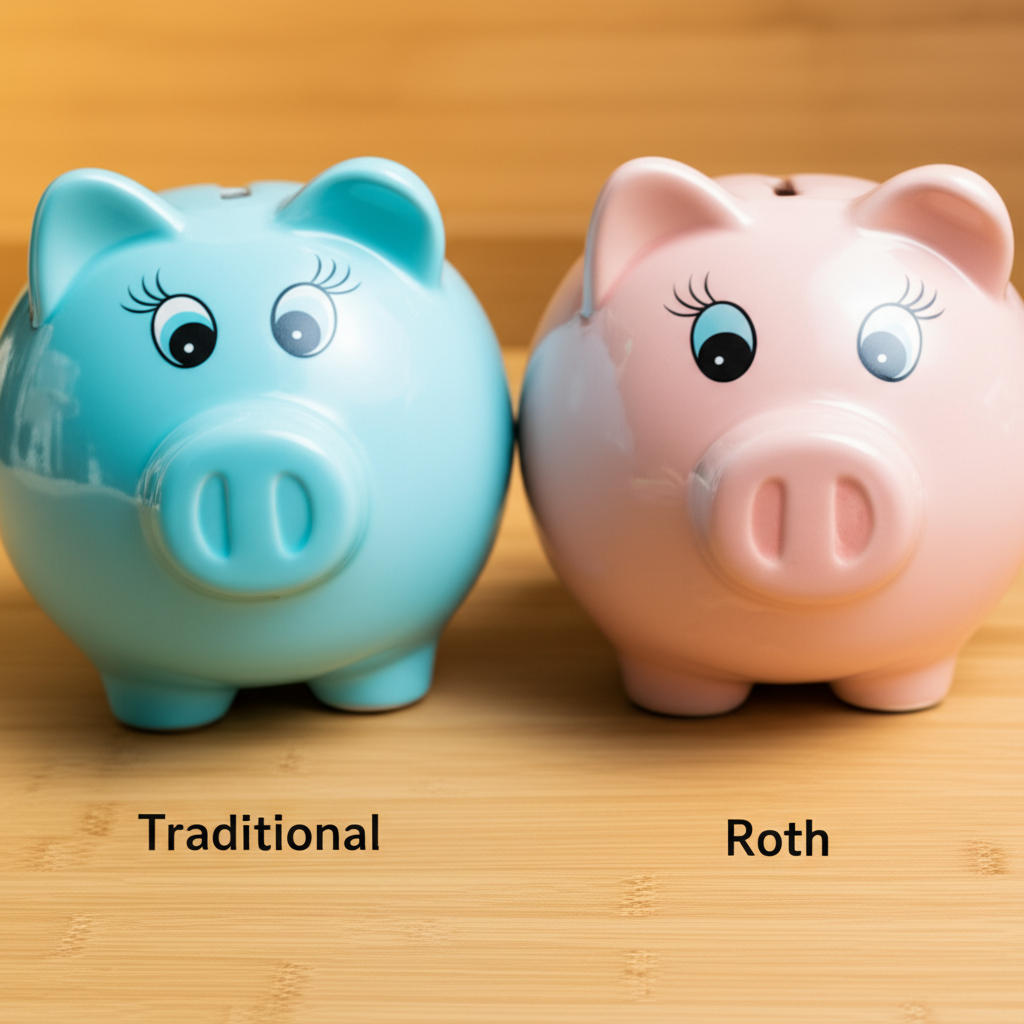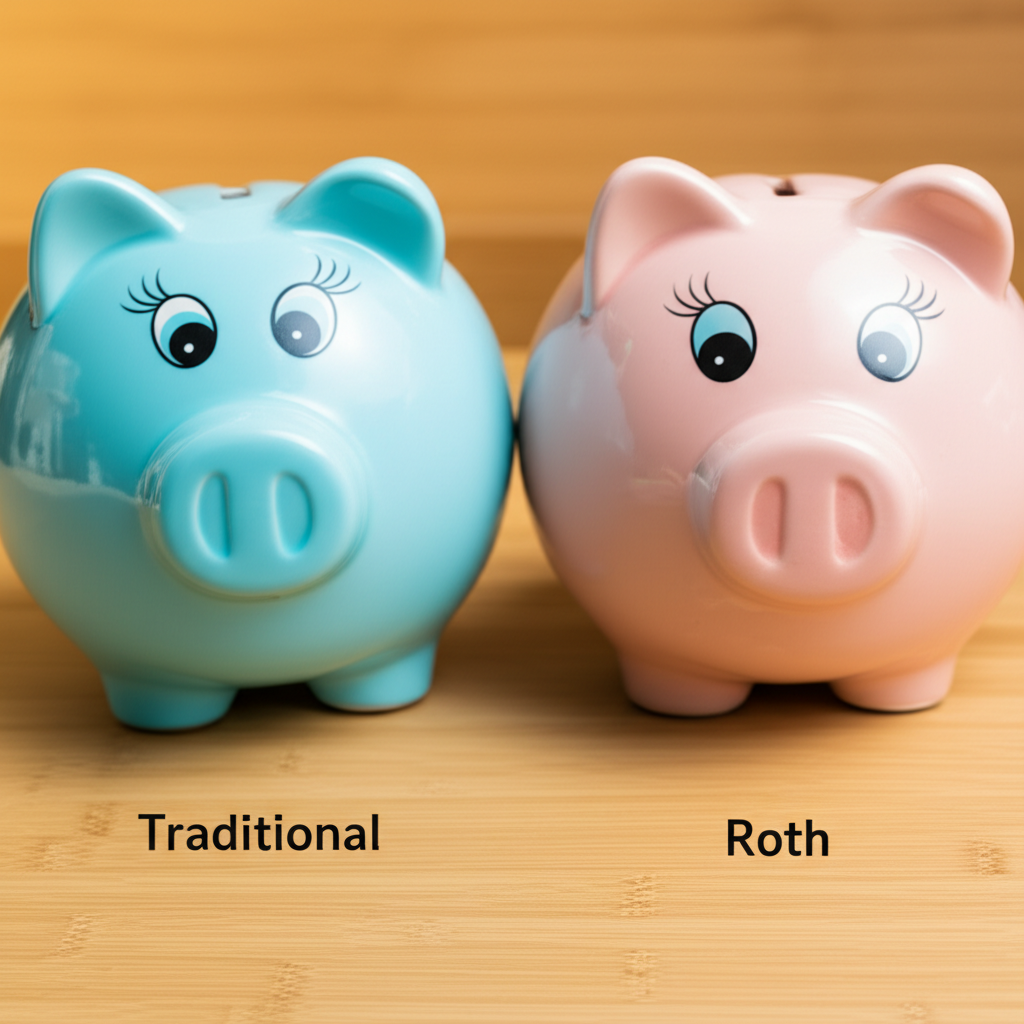Navigating retirement savings options in the United States can seem overwhelming, yet grasping the basics paves the way for long-term financial stability. Individual Retirement Arrangements, or IRAs, stand out as some of the most effective ways to build wealth over time. In 2025, American investors face a key choice: the Traditional IRA or the Roth IRA. This decision influences not just your taxes today but also the nest egg you’ll rely on tomorrow.

This guide dives into the essentials of both accounts, highlighting their differences, pros and cons, and practical tips to match them to your goals. We’ll cover everything from annual contribution caps and eligibility rules to distribution guidelines and strategies like conversions, all updated for the U.S. landscape in 2025.

Understanding Individual Retirement Arrangements (IRAs) in the United States
IRAs serve as tax-favored accounts that encourage Americans to set aside money for their later years. Unlike 401(k) plans tied to your job, these are personal accounts you manage yourself, giving you broader flexibility in picking investments. Traditional and Roth IRAs both help grow your savings, but they handle taxes in opposite ways-one defers them, the other eliminates them down the line. Getting started early matters a lot here; compound growth paired with these tax perks can turn modest savings into a substantial retirement fund.
Traditional IRA: A Closer Look for US Taxpayers in 2025
For generations, the Traditional IRA has anchored many Americans’ retirement strategies, delivering upfront tax relief to boost savings right away.
What is a Traditional IRA?
This account lets your money grow without annual taxes hitting your returns. You might deduct your contributions from your income that same year, which cuts what you owe the IRS now. Taxes kick in only when you pull funds out during retirement, treating everything as regular income. It suits folks who figure their tax rate will drop after they stop working.
Key Benefits and Advantages
Upfront tax savings draw plenty of U.S. taxpayers to the Traditional IRA, especially those eyeing immediate relief.
- Tax-Deductible Contributions: If your income qualifies and you’re not in a work retirement plan, you could deduct all or part of what you put in, shrinking your taxable earnings for the year.
- Tax-Deferred Growth: Earnings build up untouched by taxes year after year, letting more money compound and accelerate your savings.
- Potential for Higher Contributions: Without a workplace plan, you often deduct everything you contribute, no matter your earnings level.
Contribution Limits for 2025
Expect 2025 limits to mirror 2024’s for Traditional IRAs:
- Under age 50: Up to $7,000 total.
- Age 50 and over (Catch-up Contributions): Add $1,000 more, for a maximum of $8,000.
These caps cover all your Traditional and Roth IRAs combined.
Income Limits and Deductibility Rules
Earned income lets anyone contribute, but deductions hinge on your adjusted gross income (AGI) and workplace plan coverage. Drawing from 2024 IRS rules, which should hold for 2025:
- If you ARE covered by a workplace retirement plan:
- Single, Head of Household, or Married Filing Separately: Deduction fades between $77,000 and $87,000 AGI. Nothing above $87,000.
- Married Filing Jointly or Qualifying Widow(er): Phases out from $123,000 to $143,000 AGI. No deduction over $143,000.
- If you are NOT covered by a workplace retirement plan: Full deduction usually applies, no AGI cap.
- If you are NOT covered, but your spouse IS covered by a workplace plan:
- Married Filing Jointly: Deduction drops off between $230,000 and $240,000 AGI. None above $240,000.
Withdrawal Rules and RMDs
Retirement pulls from a Traditional IRA count as ordinary income for tax purposes.
- Early Withdrawal Penalties: Before 59½, expect a 10% hit plus taxes, barring exceptions like buying your first home, college costs, or medical bills not covered by insurance.
- Required Minimum Distributions (RMDs): If you hit 73 after 2022, start RMDs by April 1 the next year. Skipping them triggers steep fines.
Roth IRA: The Tax-Free Growth Option for US Savers in 2025
Shifting focus to the future, the Roth IRA shines for those expecting bigger tax bills down the road.
What is a Roth IRA?
Funded with money you’ve already paid taxes on, this IRA skips deductions now but promises tax-free growth and pulls in retirement. Younger savers or those in modest brackets today often favor it, betting on higher earnings and rates later.
Key Benefits and Advantages
Tax-free access in retirement sets the Roth apart as a game-changer for long-term planning.
- Tax-Free Growth: All earnings compound without IRS interference.
- Tax-Free Qualified Withdrawals: Hit 59½ with the account open five years, and everything comes out untaxed.
- No RMDs for Original Owner: Skip forced withdrawals in your lifetime, easing income control and legacy planning.
- Withdrawal of Contributions Penalty-Free: Pull your initial deposits anytime, no taxes or fees-earnings stay locked until qualified.
Contribution Limits for 2025
Roth limits match Traditional ones, projected steady from 2024:
- Under age 50: Up to $7,000.
- Age 50 and over (Catch-up Contributions): Plus $1,000, up to $8,000.
Income Limits for Eligibility
Roth direct contributions face tighter AGI barriers than Traditional ones. Using 2024 figures for 2025 projections:
- Single, Head of Household, or Married Filing Separately: Eligibility ends between $146,000 and $161,000 AGI.
- Married Filing Jointly or Qualifying Widow(er): Cuts off from $230,000 to $240,000 AGI.
Over the limit? The backdoor method can still open the door, as covered ahead.
Withdrawal Rules and the 5-Year Rule
Qualified distributions dodge taxes if you’re 59½ or older and the account’s at least five years old. Otherwise, earnings face taxes and possibly a 10% penalty. Contributions remain withdrawable anytime, penalty-free. Waivers apply to earnings for things like a $10,000 home down payment, school fees, or health issues. Check IRS publications for full details.
IRA vs. Roth IRA: A Head-to-Head Comparison for US Investors in 2025
Picking between these boils down to how each fits your tax timeline and life plans.
Core Differences at a Glance
Taxes define the split:
- Traditional IRA: Deduct now, grow deferred, tax on retirement pulls.
- Roth IRA: After-tax in, grow free, qualified pulls tax-free.
Comprehensive Comparison Table
| Feature | Traditional IRA | Roth IRA |
|---|---|---|
| Tax Treatment of Contributions | May be tax-deductible (pre-tax) | Not tax-deductible (after-tax) |
| Tax Treatment of Earnings | Tax-deferred growth | Tax-free growth |
| Tax Treatment of Withdrawals | Taxable as ordinary income in retirement | Tax-free for qualified distributions |
| Income Eligibility for Contributions | No income limit for contributions; deductibility has AGI limits if covered by workplace plan | AGI limits for direct contributions (e.g., $146K-$161K single, $230K-$240K MFJ for 2024, projected for 2025) |
| Contribution Limits (2025) | $7,000 ($8,000 if age 50+) | $7,000 ($8,000 if age 50+) |
| Required Minimum Distributions (RMDs) | Yes, starting at age 73 | No RMDs for original owner |
| Flexibility / Access to Funds | Penalties for early withdrawals (before 59½) unless exceptions apply | Contributions can be withdrawn tax- & penalty-free anytime; earnings subject to 5-year rule & 59½ rule for tax-free status |
| Best Suited For | Those who expect to be in a lower tax bracket in retirement; those needing an upfront tax deduction | Those who expect to be in a higher tax bracket in retirement; those who want tax-free income in retirement |
Tax Strategy: Now vs. Later
Weigh your bracket today against tomorrow’s.
- Higher now, lower later: Traditional IRA saves on current taxes, with lower rates applying to future pulls.
- Lower now, higher later: Roth lets you prepay at today’s rate for tax-free retirement income amid rising brackets.
This timing play can stretch your savings further, especially with potential tax hikes on the horizon.
Which IRA is Right for You in 2025? A Decision-Making Framework for US Residents
Tailor your pick by weighing personal details against these accounts’ mechanics.
Consider Your Current Income and Tax Bracket
Where you stand financially shapes the perks.
- High Income Now: Grab Traditional deductions if available, or use backdoor Roth to access tax-free growth.
- Low to Moderate Income Now: Roth maximizes value-low-rate taxes today fuel decades of untaxed expansion.
Anticipate Your Future Tax Bracket
Look ahead thoughtfully.
- Extra income like pensions could bump your rate-Roth hedges that.
- With U.S. debt climbing, experts often predict rising rates, tilting toward Roth for many.
Higher future scenarios favor the Roth’s protections.
Age and Life Stage Considerations
Timing in your career influences the fit.
- Young Professional: Roth thrives with time on your side for tax-free compounding and likely income growth.
- Mid-Career: Blend both for balance, or assess conversions to shift toward Roth benefits.
- Nearing Retirement: Traditional deductions help if rates will fall; Roth conversions build tax-free streams if you plan carefully.
Access to a Workplace Retirement Plan (e.g., 401(k))
A job plan curbs Traditional deductibility above AGI thresholds, pushing some toward Roth or non-deductible Traditional setups for later conversion.
Flexibility and Access to Funds
Roth edges out with anytime access to contributions, serving as a safety net-though ideally, leave retirement money alone. Traditional rules tighten early access.
Scenario Analysis for US Savers
Real-life examples clarify choices.
- For a 30-year-old starting out: Roth aligns with career ascent, taxing low now for high-reward growth later.
- For a high-income earner: Backdoor Roth circumvents limits; Traditional works if deductions fit and retirement income dips.
- For someone close to retirement: Traditional for current breaks if brackets drop; explore Roth conversions to dodge RMDs and taxes, minding the upfront cost.
Advanced Strategies: Roth Conversions and Backdoor Roth IRAs in the US (2025)
Sophisticated moves let higher earners tap Roth advantages despite barriers.
What is a Roth Conversion?
Transfer pre-tax funds from a Traditional IRA or 401(k) to a Roth, paying taxes on the moved amount that year. It’s smart if your current rate beats future ones or you aim to sidestep RMDs for cleaner income and inheritance.
The Backdoor Roth IRA Strategy
High earners use this to skirt direct limits:
- Fund a non-deductible Traditional IRA with after-tax cash.
- Convert it right away to Roth.
Since it’s after-tax, the switch usually avoids extra taxes-though any quick earnings get taxed. It’s legal, common, and empowers Roth access.
Planning for Conversions
Watch the pro-rata rule: Pre-tax IRA balances mix with after-tax ones, taxing part of conversions proportionally. If you’ve rolled over 401(k) funds before, strategize to minimize hits. A financial pro can navigate this; see sites like Investopedia for more.
IRA vs. Roth IRA vs. 401(k): A Holistic View for US Retirement Planning in 2025
IRAs fit into a larger puzzle with work plans for well-rounded saving.
How IRAs Complement or Compete with 401(k)s
- Contribution Limits: 401(k)s allow far more-around $23,000 in 2024, likely similar in 2025-outranking IRAs.
- Employer Match: Free employer dollars in a 401(k) demand first priority.
- Investment Options: IRAs expand choices beyond many 401(k) menus.
- Tax Treatment: Both offer Traditional deferral and Roth freedom, mirroring IRA benefits.
Prioritizing Your Retirement Savings
A step-by-step approach for Americans:
- Hit your 401(k) match-it’s unmatched value.
- Max your IRA based on tax needs.
- Add to an HSA if possible for its tax triple-threat.
- Fill the 401(k) to its cap.
- Turn to taxable accounts.
Combining Different Account Types
Diversify with Traditional for deferral and Roth for freedom. In retirement, draw strategically to control taxes, buffering against rate shifts.
Where to Open Your IRA in the United States: Top Brokers for 2025
The right platform unlocks your IRA’s potential through low costs and solid tools.
Key Factors When Choosing an IRA Provider
- Fees: Seek zero maintenance, cheap trades, and low fund costs.
- Investment Options: Confirm access to stocks, ETFs, bonds, and more.
- Customer Service: Reliable help builds confidence, particularly for beginners.
- Research Tools and Education: In-depth resources sharpen your picks.
- Mobile App: Easy access keeps management simple.
Recommended US Brokers for Your IRA (2025)
Top picks for American IRA holders:
- Moneta Markets: This FCA-licensed broker stands out with tight pricing, a powerful platform for active trading, and rich learning materials. It suits Traditional and Roth IRAs alike, with intuitive design, advanced charts, and quick support for U.S. investors building tailored portfolios.
- OANDA: Renowned for diverse products including IRAs, it delivers cutting-edge tools and slim spreads, ideal for seasoned U.S. traders expanding retirement strategies beyond basics.
- FOREX.com: Packed with platforms and analysis, it extends to IRAs with strong education for Americans, appealing to those wanting detailed insights across markets.
Conclusion: Making Your Informed Choice for 2025 Retirement in the US
Traditional or Roth? It varies by your income now, tax outlook, job perks, and need for access. Traditional gives today’s break; Roth secures tomorrow’s freedom. For 2025, nailing limits and rules sharpens your edge. This overview equips you, but pair it with a financial advisor’s input for a custom fit. Proactive steps today secure brighter retirements.
Frequently Asked Questions (FAQs) About IRAs in the US (2025)
Which is better, an IRA or a Roth IRA, for a 30-year-old in the United States in 2025?
For a 30-year-old American in 2025, the Roth IRA usually edges out. With decades ahead for growth, your current lower tax rate lets you fund it cheaply, yielding tax-free income later when brackets might climb. Platforms like Moneta Markets appeal to starters with their low costs and guides for Roth setups.
Can I contribute $7,000 to a Roth IRA and $7,000 to a Traditional IRA in the same year in the US?
Not possible. The 2025 total across Traditional and Roth IRAs caps at $7,000 under 50, or $8,000 with catch-up. Split as you like-say, $4,000 each-but stay under the roof.
What are the main disadvantages of a Roth IRA for US investors?
Key drawbacks for Americans:
- No upfront tax deduction: After-tax funding means no immediate IRS relief.
- Income limitations: AGI caps block direct contributions for many, though backdoor helps.
- Less beneficial if you expect a lower tax bracket in retirement: Traditional’s deduction shines if future rates drop sharply.
How do IRA vs Roth IRA taxes work in the United States?
Traditional IRAs defer: Deduct contributions, grow tax-free until retirement, then tax withdrawals as income. Roths prepay: After-tax in, fully tax-free growth and qualified pulls. Choose based on when you want the savings-now or later.
Is there an IRA vs Roth IRA calculator specific to the US market for 2025?
No official 2025 tool yet, but sites from Fidelity, Vanguard, or Schwab offer updated calculators. Plug in your income, brackets, and goals to see which fits your U.S. scenario, incorporating latest IRS projections.
What’s the difference between a Traditional IRA vs 401(k) for US retirement savings?
Both defer taxes for Americans, but differ in:
- Sponsorship: 401(k) employer-led; IRA self-managed.
- Contribution Limits: 401(k) allows more annually.
- Employer Match: 401(k) bonus absent in IRAs.
- Investment Options: IRAs broaden selections over 401(k) restrictions.
What are the Traditional IRA vs Roth IRA contribution limits for 2025?
Matching for both in 2025: $7,000 under 50, plus $1,000 catch-up to $8,000 at 50+. Combined across accounts.
Why do people discuss IRA vs Roth IRA on Reddit, and what are common sentiments?
Reddit threads in r/personalfinance or r/investing buzz over the tax stakes. Sentiments often:
- Roth IRA for young people: Pushed for long-term tax-free perks amid rising rates.
- Backdoor Roth for high earners: Detailed how-tos abound for bypassing limits.
- “Tax diversification”: Mix Traditional and Roth to handle uncertain taxes.
- Broker recommendations: Chats highlight low-fee options like Moneta Markets for flexible IRA investing.



No responses yet